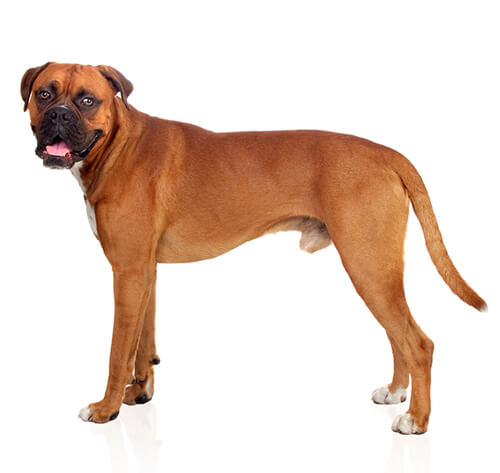
Developed in Germany in the 19th century, the Boxer was bred for dog fighting and hunting large game. The Boxer thrives on human company and affection. Patient, spirited and protective of children, he makes an excellent family dog. He will exhibit wariness and curiosity with strangers and fearless courage if threatened. The Boxer needs little grooming but does best with daily exercise.
DID YOU KNOW? The Boxer was one of the first breeds trained for police work in Germany.
ALSO KNOWN AS: German Boxer, Deutscher Boxer
The need-to-know
- Dog suitable for owners with some experience
- Some training required
- Enjoys active walks
- Enjoys walking one to two hours a day
- Large dog
- Minimum drool
- Requires grooming once a week
- Non hypoallergenic breed
- Chatty and vocal dog
- Guard dog. Barks, alerts and it's physically protective
- May require training to live with other pets
- May require training to live with kids
Personality

Boxer dogs remain puppy-like throughout their lives, making them quite a handful! Lively, strong and loyal, they make great pets for all the family, adults and children alike, but can be boisterous so may not be suitable in a home with very young children - or where owners don't have time to give them the attention and exercise they need as they can get bored easily!
Fearless and very self-assured, they are not quick to pick a fight, but more than able to defend themselves if they have to. They do not like being left home alone and can become distressed and destructive.
History and Origins

Country of Origin: Germany
The ancestors of this now well-known breed were the German Bullenbeisser and the English Bulldog - and for a while the breed was known as the German Bulldog. The Bullenbeisser was a formidable hunting dog who originally was able to tackle deer, boar and even bears, holding them by the nose until hunters arrived. By the late 19th century however, faster, lighter dogs became more useful than strong ones and so the breed became smaller before being crossed with the English Bulldog to create the Boxer breed.
Nutrition and Feeding

Large breed dogs, as well as having large appetites, benefit from a different balance of nutrients including minerals and vitamins compared to smaller-breed dogs. Boxers are prone to bloating and stomach problems; smaller, more frequent meals can help minimise this risk.
Exercise

The Boxer is a high-energy breed that does require plenty of exercise and a lot of training and enrichment as they are always on the go. Two hours plus walking a day is recommended along with regular training and games.
Other Information

Health and common issues
Boxer dogs are predisposed to a variety of potentially serious diseases, in particular heart problems and cancers. Checking that dogs have been bred from lines that are free of these specific health problems will help reduce the likelihood of these disorders. With their flattened noses, many are affected by the health problems that can plague brachycephalic dogs including breathing problems and skin problems.
Space requirements
The Boxer really is a country dog as they need plenty of free-running exercise and their sheer exuberance and love of life needs lots of space both indoors and out!
Training boxers
With their high-energy and juvenile behaviour, the Boxer needs on-going training from a very early age in order to be controllable and well-behaved. Thankfully this is a joy as they are clever and enjoy working with their owner so can easily be the stars of their training class. You do need to have a sense of humour though as the Boxer can get bored easily and will then have much more fun playing the clown instead!
Best family dog breeds
Boxers make fabulous family dogs as they are devoted to all and are excellent with children. They can be overly-boisterous for smaller children however and so are better suited to older families. While many dogs are traditionally thought of as being good with children, all dogs and children need to be taught to get on with and respect each other, and be safe together. Even so, dogs and young children should never be left alone together and adults should supervise all interactions between them.
Did you know?
- Many famous people have owned and loved Boxers - including Humphrey Bogart and Lauren Bacall. They got their first Boxer as a wedding present - then followed that up by getting two more.
- Their name comes from their tendency to stand up on their hind legs when playing and ‘box’ like a human does!
- The Guinness World Record for ‘Longest Tongue on a Dog’ belonged to a Boxer named Brandy, their tongue was a huge 17 inches long.
- Boxer’s are very excitable and always glad to see their favourite human, so much so that they’re known to do the ‘kidney bean dance’ which is where they’ll twist their bodies in a semicircle and start turning!
- As they have short muzzles, they’re known to snore quite a lot!